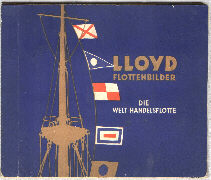 |
|
Album cover
|
 |
|
Album cover
|
Issued by: Martin Brinkmann A.G. Zigarettenfabrik, Bremen with Lloyd
brand cigarettes.
No. in set: 200
Date of issue: 1933.
This is the date given by Köberich. Card 145 shows the incomplete French
liner "Normandie" noting it was launched in 1932 and is due to go
into service in 1934 which would seem to confirm this.
Errors and Variations.
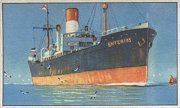 |
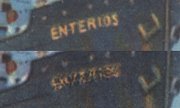 |
64 |
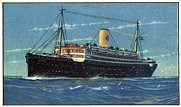 |
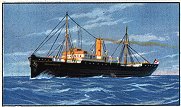 |
182 |
Card 64 shows the ship "Entrerios". Unfortunately the artist forgot the first "r". In the amended version of the card, the mistake was covered up with "rust".
There are two versions of card 182. The backs are the same and describe a freighter. As the card on the left is clearly a passenger ship, this is presumably the wrong picture and was subsequently replaced by the correct one. This would also seem to imply that more pictures were originally drawn than were eventually used for the set. Thanks to Bernd Neumann of Kirchlinteln I know more about this wrong card than most of the correct cards in the set. He has discovered that it depicts the passenger steamer "Drottningholm", originally named "Virginian" and built for the Allan line of Glasgow by Alexander Stephen and sons. It was used as a troop transport during WW1 and from 1920 - 1948 it belonged to the Svenska Amerika Linie. During WW2 it was used as a Red Cross ship. From 1948 it belonged to Home Lines of Panama and sailed under the names "Brasil" and "Homeland". It was finally scrapped in 1955, the oldest trans-atlantic passenger ship.
About the set.
 Die
Welthandelsflotte is a set showing merchant ships of the world's major maritime
nations. The pictures are all hand drawn and the artist obviously put a lot
of effort into drawing not only the ships but also detailed backgrounds to give
a realistic appearance to the subjects. The backs of
the cards give information about the ships including the name and owner
and a variety of other details such as the builders, date of launch, weight,
cargo capacity, top speed, engine power and the route on which the ship normally
worked. Although the information is in German, it is also easily understandable
for English-speaking people.
Die
Welthandelsflotte is a set showing merchant ships of the world's major maritime
nations. The pictures are all hand drawn and the artist obviously put a lot
of effort into drawing not only the ships but also detailed backgrounds to give
a realistic appearance to the subjects. The backs of
the cards give information about the ships including the name and owner
and a variety of other details such as the builders, date of launch, weight,
cargo capacity, top speed, engine power and the route on which the ship normally
worked. Although the information is in German, it is also easily understandable
for English-speaking people.
The set is divided into 33 groups, most containing six cards, the last containing eight. The first nine groups show ships of the Norddeutscher Lloyd and the Hamburg-Amerika lines, later to become Hapag-Lloyd. There then follow two groups of the Hamburg-South America Steamship Company, a group for the "Hansa" Steam Shipping Company of Bremen, six groups showing assorted companies and two groups of special ships. Following this come ships from the rest of the world with three groups for England, a group each for the United States, France, Holland, Japan, Italy, Norway, Russia, Sweden/Denmark, Spain/Portugal and various other countries.
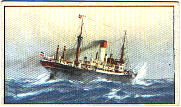 The first 120 cards show
German ships ranging from small cargo ships to large passenger liners. Card
1 starts with the passenger liner "Bremen" of Norddeutsche Lloyd,
launched in 1928. The card gives its maximum speed of 28 knots, proudly noting
that this was a record and that the "Bremen" shares the Blue Riband
of the Atlantic with its sister ship the "Europa". The "Europa"
itself is shown on card 2. This ship had an eventful history. She was almost
destroyed by fire shortly before completion in 1929. Repaired and put into service,
she was subsequently seized after world war 2 and given to France as reparation
for the "Normandie", which is shown on card 145. The set continues
with an assortment of passenger and freight steamers including several special
purpose ships. Card 109 for example shows a small unnamed cable-laying steamer.
The card notes that Germany was forced to give its large cable-laying ships
to the "enemy alliance" after the first world war. This is one of
the few references in the set to the Allies seizing Germany's entire merchant
fleet after world war 1, a fact on which the set is remarkably restrained. The
"Bremen" and the "Europa" were the pride of Germany's rebuilt
post-ww1 merchant fleet.
The first 120 cards show
German ships ranging from small cargo ships to large passenger liners. Card
1 starts with the passenger liner "Bremen" of Norddeutsche Lloyd,
launched in 1928. The card gives its maximum speed of 28 knots, proudly noting
that this was a record and that the "Bremen" shares the Blue Riband
of the Atlantic with its sister ship the "Europa". The "Europa"
itself is shown on card 2. This ship had an eventful history. She was almost
destroyed by fire shortly before completion in 1929. Repaired and put into service,
she was subsequently seized after world war 2 and given to France as reparation
for the "Normandie", which is shown on card 145. The set continues
with an assortment of passenger and freight steamers including several special
purpose ships. Card 109 for example shows a small unnamed cable-laying steamer.
The card notes that Germany was forced to give its large cable-laying ships
to the "enemy alliance" after the first world war. This is one of
the few references in the set to the Allies seizing Germany's entire merchant
fleet after world war 1, a fact on which the set is remarkably restrained. The
"Bremen" and the "Europa" were the pride of Germany's rebuilt
post-ww1 merchant fleet.
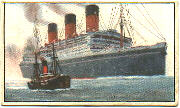 The English section
shows several famous passenger liners. Card 121 shows the White Star Line's
"Majestic" which started life as one of the Hamburg-Amerika line's
"big three" liners, the "Bismark". Having laid incomplete
during world war 1, the Germans were ordered to complete her and hand her over
the the British as war reparation for the loss of the Britannic. They were not
very keen to do this, and the work took until 1922. Even then, the White Star
line discovered the funnels painted in the Hamburg-Amerika line's colours and
the name "Bismark" painted on the bow. For good measure, the captain's
cabin had been converted into a rubbish store.
The English section
shows several famous passenger liners. Card 121 shows the White Star Line's
"Majestic" which started life as one of the Hamburg-Amerika line's
"big three" liners, the "Bismark". Having laid incomplete
during world war 1, the Germans were ordered to complete her and hand her over
the the British as war reparation for the loss of the Britannic. They were not
very keen to do this, and the work took until 1922. Even then, the White Star
line discovered the funnels painted in the Hamburg-Amerika line's colours and
the name "Bismark" painted on the bow. For good measure, the captain's
cabin had been converted into a rubbish store.
The series continues with the White Star Line's "Homeric", another ship acquired by the British as war reparations and which started life as the German liner "Columbus". Interestingly, card 3 shows another liner "Columbus" of the Norddeutsche-Lloyd line. It was built by the same shipyard, F. Schichau of Danzig, both ships being launched in 1922. This "Columbus" was the sister ship of the other and started life as the "Hindenburg". It was incomplete at the end of WW1 and was one of the few ships not taken in reparations. Renamed after its sister, it was completed and went into service alongside the "Bremen" and "Europa". The English section then continues with the "Albertic" and the "Britannic", a namesake of the Titanic's sister ship launched in 1930.
Following on from White Star comes Cunard whose ships include the second of the Hamburg-Amerika line's big three in the set, the "Berengaria" (card 135). Originally named the "Imperator" it had been idle during the war which it survived undamaged, and was finally given to the British as reparation for the "Lusitania". Also shown on card 125 is the "Lusitania"'s sister ship the "Mauretania", launched in 1907 and still going strong. This ship held the Blue Riband for over twenty years until it was taken away by the "Bremen"
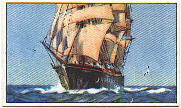 Card 139 shows the US
ship "Leviathan". This ship had an interesting history, having started
life as the german ship "Vaterland", the third of the German big three
shown in the set. It was the largest ship afloat in 1914. It was caught in New
York harbour at the start of world war 1, or "this insane war" as
Albert Ballin the general director of the Hamburg-Amerika line called it. At
the time, the USA were neutral and the ship was ordered to stay there to avoid
falling into enemy hands. She stayed there until 1917 still "awaiting orders".
With the entry of the USA into the war in 1917, she was officially seized, having
been captured in an amusing military action which effectively consisted of the
crew being taken ashore to Ellis island and offered American citizenship. She
spent some time as a troop ship before being restored to a passenger liner and
was scrapped in 1938. Meanwhile, Albert Ballin, having seen his life's work
of creating the world's largest shipping company destroyed, comitted suicide
soon after the end of the war. Card 33 shows the steamer "Albert Ballin"
of the rebuilt Hamburg Amerika company, launched in 1922 and named in his honour.
Card 139 shows the US
ship "Leviathan". This ship had an interesting history, having started
life as the german ship "Vaterland", the third of the German big three
shown in the set. It was the largest ship afloat in 1914. It was caught in New
York harbour at the start of world war 1, or "this insane war" as
Albert Ballin the general director of the Hamburg-Amerika line called it. At
the time, the USA were neutral and the ship was ordered to stay there to avoid
falling into enemy hands. She stayed there until 1917 still "awaiting orders".
With the entry of the USA into the war in 1917, she was officially seized, having
been captured in an amusing military action which effectively consisted of the
crew being taken ashore to Ellis island and offered American citizenship. She
spent some time as a troop ship before being restored to a passenger liner and
was scrapped in 1938. Meanwhile, Albert Ballin, having seen his life's work
of creating the world's largest shipping company destroyed, comitted suicide
soon after the end of the war. Card 33 shows the steamer "Albert Ballin"
of the rebuilt Hamburg Amerika company, launched in 1922 and named in his honour.
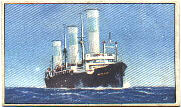 Not all ships of the
period were steam ships however. Sail had still not been completely ousted and
there were still a few sailing ships about. Card 98 for example shows the four-masted
bark "Pudua" of the Laeisz company of Hamburg. Launched as late as
1926, she was engaged in trade between Hamburg and the American west coast.
Nevertheless sail as a viable commercial proposition was almost finished. When
the Finnish bark "Herzogin Cecilie" ran aground off the Devon coast
in 1936 there was insufficient interest to repair her. Large sailing ships continued
as training ships. Card 113 shows the school ship "Deutschland" in
full sail.
Not all ships of the
period were steam ships however. Sail had still not been completely ousted and
there were still a few sailing ships about. Card 98 for example shows the four-masted
bark "Pudua" of the Laeisz company of Hamburg. Launched as late as
1926, she was engaged in trade between Hamburg and the American west coast.
Nevertheless sail as a viable commercial proposition was almost finished. When
the Finnish bark "Herzogin Cecilie" ran aground off the Devon coast
in 1936 there was insufficient interest to repair her. Large sailing ships continued
as training ships. Card 113 shows the school ship "Deutschland" in
full sail.
The set also shows several unusual ships. Card 81 shows the experimental ship "Barbara". What at first sight appear to be large funnels are in fact rotating cylinders which make use of the Magnus effect to propel the ship. By rotating the three cylinders in various combinations of directions, the ship could be propelled through the water or turned around on the spot. This was the second ship of the type, the original "Flettner Rotor Ship" having had only two rotors. However like sailing ships, wind is necessary, and interesting as this novel method of propulsion was, it never caught on.